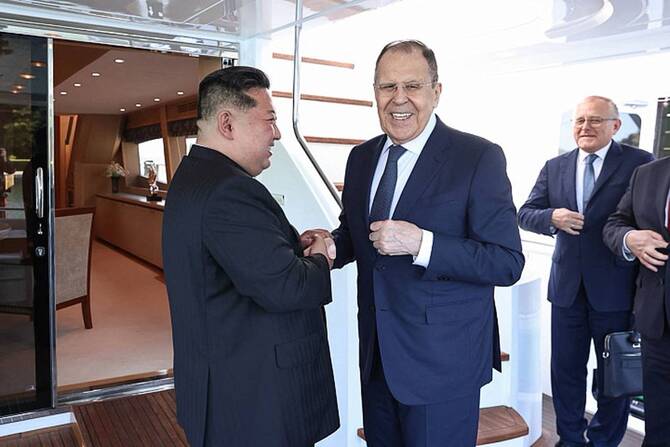KYIV, Ukraine: Russia said Tuesday that its forces checked an effort by Ukrainian troops to expand a stunning weeklong incursion into the Kursk region, as a Ukrainian Foreign Ministry spokesman said Kyiv has no intention of occupying Russian territory.
Russian army units, including fresh reserves, aircraft, drone teams and artillery forces, stopped Ukrainian armored mobile groups from moving deeper into Russia near the Kursk settlements of Obshchy Kolodez, Snagost, Kauchuk and Alexeyevsky, a Russian Defense Ministry statement said.
Meanwhile, Ukrainian Foreign Ministry spokesman Heorhii Tykhyi said the cross-border operation was aimed at protecting Ukrainian land from long-range strikes launched from Kursk.
“Ukraine is not interested in taking the territory of the Kursk region, but we want to protect the lives of our people,” Tykhyi was quoted as saying by local media.
He said Russia had launched more than 2,000 strikes from the Kursk region in recent months using anti-aircraft missiles, artillery, mortars, drones, 255 glide bombs and more than 100 missiles.
“The purpose of this operation is to preserve the lives of our children, to protect the territory of Ukraine from Russian strikes,” he said.
The commander of the Ukrainian military, Oleksandr Syrskyi, said in a video posted Tuesday to President Volodymyr Zelensky’s Telegram channel that Ukraine now controls 74 settlements in the Kursk region.
Ukrainian troops have continued to advance, gaining control over 40 square kilometers (15 square miles) of territory in the past 24 hours, Syrskyi said.
“Fights are ongoing along the entire front line. The situation, despite the high intensity of combat, is under control,” he added.
Ukraine’s Western partners have said the country has the right to defend itself, including by attacking across the border. Polish Prime Minister Donald Tusk said Tuesday that he backed the Ukrainian operation, though he said Kyiv officials did not consult him about it beforehand.
Russian military actions in Ukraine bear “the hallmarks of genocide, inhumane crimes, and Ukraine has every right to wage war in such a way as to paralyze Russia in its aggressive intentions as effectively as possible,” Tusk said.
Kremlin forces intensified their attacks in eastern Ukraine. Ukraine’s General Staff said Tuesday that over the previous 24 hours, Russian troops launched 52 assaults in the area of Pokrovsk, a town in Ukraine’s Donetsk region that is close to the front line. That’s roughly double the number of daily attacks there a week ago.
Ukraine’s undermanned army has struggled to hold back the bigger, better-equipped Russian forces in Donetsk.
The Ukrainian military claims that its charge onto Russian soil that began Aug. 6 has already encompassed about 1,000 square kilometers (386 square miles) of Russian territory. The goals of the swift advance into the Kursk region have been a closely guarded military secret.
Analysts say a catalyst may also have been Ukraine’s desire to ease pressure on its front line by attempting to draw the Kremlin’s forces into defending Kursk and other border areas. If so, the increased pressure around Pokrovsk suggests Moscow did not take the bait.
Ukraine’s ambitious operation — the largest attack on Russia since World War II — has rattled the Kremlin. It compelled Russian President Vladimir Putin to convene a meeting Monday with his top defense officials.
Apparently, Ukraine assembled thousands of troops — some Western analysts estimate up to 12,000 — on the border in recent weeks without Russia noticing or acting.
About 121,000 people have been evacuated from Kursk or have fled the areas affected by fighting on their own, Russian officials say. The Institute for the Study of War, a Washington-based think tank, said it has seen geolocated footage indicating that Ukrainian forces advanced as much as 24 kilometers (15 miles) from the border.
The Russian Defense Ministry appeared to support that claim when it said Tuesday it had also blocked an attack by the units of Ukraine’s 82nd Air Assault Brigade toward Maryinka, which is about that distance from Ukraine.
Russian state television on Tuesday showed residents from evacuated areas lining up in buildings and on the street to receive food and water. Volunteers were pictured distributing bags of aid, while officials from the country’s Ministry of Emergency Situations helped people, including children and older people, off buses.
“There is no light, no connection, no water. There is nothing. It’s as if everyone has flown to another planet, and you are left alone. And the birds stopped singing,” an older man called Mikhail told Russian state television. “Helicopters and planes fly over the yard and shells were flying. What could we do? We left everything behind.”
A motive behind Ukraine’s bold dive into Russia was to stir up unrest, according to Putin, but he said that effort would fail.
The successful border breach also was surprising because Ukraine has been short of manpower at the front as it waits for new brigades to complete training.
Dara Massicot, an analyst at the Carnegie Endowment, said the Ukrainian breakthrough was a smart move because it exploited gaps between various Russian commands in Kursk: border guards, Ministry of Defense forces and Chechen units that have been fighting on Russia’s side in the war.
Russian command and control is fractured in Kursk, Massicot said on X late Monday.
The Ukrainian Army’s General Staff announced Tuesday that it was establishing a 20-kilometer (12-mile) restricted-access zone along Russian-Ukrainian border in the northeastern Sumy region, which borders Kursk.
The measures were introduced because of the increasing intensity of combat in the area and the rising presence of Russian reconnaissance and sabotage units there, a statement said.






























